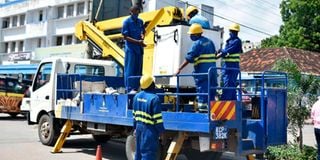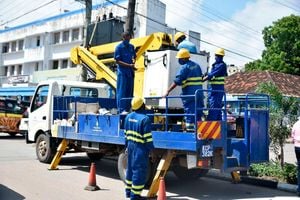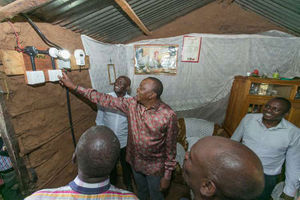
Kenya Power technicians carry out repairs on a transformer on Haile Selassie Road in Mombasa on December 5, 2020.
The cost of getting connected to electricity supply remains as high as ever, but so is the time needed to even get it. That is the twin nightmare Kenyans face when trying to literally get themselves some light and power.
On paper, the process is a simple A-B-C. According to information from Kenya Power, the country’s power distribution monopoly, customers need copies of their national identity card, PIN certificate, title deed and land search documents for ownership of property, a duly filled supply contract form and wiring certificates as well as a sketch map of the route to the premises supply is required.
Easy as pie, isn’t it?
The company thereafter generates a quotation based on the applicant’s specifications and issued. The quotation is valid for 90 days.
But it is these usually huge quotations that often leave customers with their mouths agape, as most households and small businesses can barely afford the cost it takes to get connected to power.
“I was asked by Kenya Power to pay Sh3 million to get connected. This would also cater for the purchase of a transformer to serve my connection,” one customer told the Daily Nation.
He has, at least for now, abandoned any plan to secure connection to the national power grid.
But he is not alone.
In a 2021 interview with Nation, steel billionaire Narendra Raval shocked the country when he revealed that Kenya Power gave him a quotation of Sh2.8 billion to connect electricity to one of his clinker factories in Emali.
He decided to build his own power generation plant, which he said saves him millions of shillings in power costs annually.
“I now produce 28 megawatts of power and I plan to generate my own power in all my other factories to ensure that we are self-reliant,” said Mr Raval at the time.
It is no secret that millions of customers are facing the same challenge.
Even for those who can afford the quotation, the connection is delayed for months or even years as the company grapples with a shortage of transformers and meters.
Kenya Power Managing Director Dr Joseph Siror, in an interview with Nation, said the utility has been struggling to buy equipment and material due to court cases that have challenged the issuance of supply contracts.
“Until September last year, there were no material coming into the company. Over that one-year period, there were about six major litigations which were raised which touched on the most critical equipment; meters and transformers,” said Dr Siror.
But even for those who eventually manage to get connected to the grid, getting a reliable power supply from the utility has remained elusive. Indeed, some of the causes of the power outages are out of Kenya Power’s control.
For instance, Kenyans were hit with a nationwide power blackout in December which was the third in as many months and the sixth in three years, raising fresh concerns over the reliability and safety of the country’s electricity supply.
The most recent nationwide outage was caused by a surge in demand in the Western region, causing the Kisumu-Muhoroni 132 kilovolt (kV) line to trip.
It is therefore little surprise that the number of hours that Kenyans are spending in the darkness caused by the outages remains high, according to official data from the Energy and Petroleum Regulatory Authority (Epra).
It shows that the System Average Interruption Duration Index (SAIDI), which describes how long on average each customer was without power in the reporting period, hit a high of 12.75 hours in March 2023.
This was a sharp increase from just 6.9 hours in July of the previous year.
“On average customers lacked power for 8.37 hrs per month. This index was highest in November 2022 (10.63hrs) and March 2023 (12.75) due to system disturbances that resulted in national blackouts,” said Epra.
The nationwide blackouts were caused by numerous factors, including a surge in demand that overloads the low-capacity transmission lines that were not built to handle such loads and sudden loss in generation from the main generation plants.
However, the majority of power outages are localised, affecting smaller units such as a village, an estate, a street or an institution. These outages are squarely within the utility’s control and that gives consumers a headache as most of them go unnoticed by Kenya Power.
This is also where the problem of the thousands of faulty transformers that have been procured by the company over the years comes into play.
Distribution transformers help to step down high voltage power to the level that is used by final customers such as households, schools and hospitals.
When these transformers are overloaded, they trip, leading to a power outage. But tripping is not the only problem that a transformer can face. Other damages can be much more severe therefore necessitating lengthy repairs or replacement.
But this is where there has been a challenge. Kenya Power’s official handle on X is filled with reports of faulty transformers on a near-daily basis.
Many of the transformers are overloaded, which means that they serve more customers than they can handle. This leads to frequent tripping, leading to regular loss of power.
This has been made worse by Kenya Power’s slackness to add enough transformers in high-demand areas to stabilise supply.
This month alone, some of the areas where Kenya Power has told its customers that their transformer is faulty include Junju in Kilifi, Ndenderu, Githurai, Chokaa and Ruaka.
“Our transformer was taken on Tuesday now we are in the dark, food (and) medicine spoiled, water cannot be pumped, where is our transformer?” posed one user with the handle @flourishing001 on X.
The issue of faulty transformers being procured by Kenya Power has been long-running, even attracting the scrutiny of lawmakers.
In the past, the company has come under the spotlight for purchasing key equipment from unscrupulous vendors instead of high-quality manufacturers.
Last year, Members of Parliament (MPs), during their probe into the issues ailing the power sector, proposed officials be personally held liable if found to have procured faulty or substandard power equipment.
“That is the right direction this country should go so that any government officer who purchases faulty transformers or makes the taxpayer lose money should be held personally liable,” Endebess MP Dr Robert Pukose told Parliament in April.
Another issue the company has faced is theft and vandalism of transformers for their metal and oil.
To deal with the growing casesv of faulty transformers, Kenya Power has repair sheds in Nairobi, Mombasa and Kisumu.
The issue has been amplified by growing cases of vandalism of transformers and copper wires. Last year alone, the company says it lost 214 transformers to vandalism.
The issue of vandalism is serious, even forcing the government to designate electricity transmission sub-stations and power infrastructure as restricted areas to fight against vandalism.
“Last year, we lost over 214 transformers. If you put the average value of each transformer at Sh1 million, we are talking about losses of more than Sh214 million,” said Dr Siror.
“The saddest part is all the customers who are using these services who were inconvenienced, and it happened at a time when there were no new transformers,” he said.








